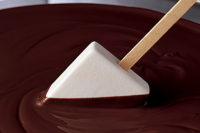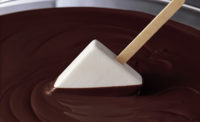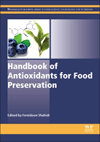Dispelling some misperceptions about chocolate and cocoa in dairy
We blast some misperceptions about chocolate and cocoa in dairy




An old Reese’s Peanut Butter Cups commercial tagline calls chocolate and peanut butter “two great tastes that taste great together.” And it’s right. But chocolate and peanut butter arguably can’t hold a candle to chocolate and dairy.
Need proof? Per Innova Market Insights, chocolate’s been the most popular flavor among newly launched milk-based drinks and ice creams, and the second most popular brown flavor for creamers and yogurts, for five years running.
“Of all new dairy products launched in the past five years, milk chocolate dominates the field with 68.6%, followed by dark chocolate at 7.1% and cocoa at 6.5%,” said Brian Wilson, application lab manager for Prova US, Danvers, Mass.
The elemental harmony of the chocolate-dairy marriage is just that — elemental.
But that doesn’t mean that formulating dairy with cocoa and chocolate is elementary. All three systems are chemically and physically complex, and their behaviors and properties don’t always “agree” in a finished product environment. As a result, misperceptions and misgivings about working with chocolate and cocoa in dairy abound.
But as their continued dominance in everything from pudding to protein shakes attests, chocolate and cocoa belong in dairy. And suppliers of chocolate and cocoa ingredients are doing everything they can to make sure that’s just where they wind up — tasting as great together as ever.
Cocoa and yogurt do mix
So why do chocolate, cocoa and dairy complement each other so well? According to Katy Cole, technical services manager, Cargill Cocoa & Chocolate, Minneapolis, the secret to their happy marriage lies in the marriage of cocoa and chocolate’s bitter notes with dairy’s “sweet and bland” profile.
“Most dairy applications use alkalized cocoa powders, and the neutral pH of a lightly alkalized cocoa powder blends well with the neutral pH of many milk- and cream-based applications,” she added.
But not all milk- and cream-based applications are neutral in pH — which might explain why one of the more stubborn myths surrounding chocolate and dairy is that yogurt and cocoa are incompatible.
“The basis for this belief is that the bitterness from flavors such as cocoa doesn’t combine well with the sour notes of fermented dairy,” explained Wouter Stomph, senior manager, product development and innovation, North America, Olam Cocoa for the deZaan and Huysman cocoa brands, Chicago.
Blend these noncomplementary profiles in less-than-ideal proportions, he said, and the resulting bitterness and harsh aftertaste may be off-putting.
What’s more, when manufacturers do give chocolate-flavored yogurt a chance, they often find they need to formulate more sugar into the matrix to mask what Stomph calls “the poor flavor profile.”
So perhaps it’s no coincidence that of the 157 chocolate-flavored new dairy launches Mintel’s Global New Products Database tracked over the past year, a mere 21 were in the spoonable yogurt category. But with cocoa and chocolate’s popularity growing, formulators have to find a means of pairing yogurt’s more delicate taste and lower pH with a classic cocoa and chocolate profile, bitterness and all.
“Navigating this process,” Stomph said, “can create significant challenges for dairy producers. As with most issues, the solution lies in finding and managing the right balance.”
For example, his company offers a mild cocoa powder with an enhanced, fruity bouquet that’s specially designed not to be bitter. Branded Fresco F11FR, it lets dairy developers “infuse robust chocolate and cocoa flavors” into yogurt preparations or syrups, Stomph said. The ingredient’s reduced bitterness also translates into less reliance on sugar or masking agents to cover any flavor defects.
Full-spectrum flavor (and color)
But the yogurt myth is only one misperception hovering over the use of cocoa in dairy. Another involves the number of cocoa color and flavor options from which dairy developers can choose. And the answer is: more than they might think.
“I can’t count the number of times a customer’s thought the options for cocoa powder were limited to what you can buy in the grocery store,” Cole said. “This is an understandable misconception, as many retailers oftentimes only offer two options: natural or European-style. But in reality, there’s a wide palate of cocoa powder colors, ranging from light brown/yellowish to dark brown or dark red and even black.”
There’s a wide palate of flavors, too.
“The flavor profile differences across the alkalization spectrum are numerous,” Cole affirmed. “As a result, finding the optimal combination of color and flavor profiles can sometimes seem daunting.
“To help customers understand the range, we often conduct a tasting session starting with nonalkalized powder and progressing to light alkalized, red alkalized and black. This grounds them in the basics and leaves them with an understanding that there are many options for color and flavor.”
Another common misconception, Stomph noted, is that natural cocoa powders — those that are not alkalized — are synonymous with bland-tasting cocoa. His company’s deZaan TrueDark cocoa powder, though natural, provides “the same powerful cocoa flavor and rich brown color as an alkalized cocoa powder while still allowing for clean labeling,” he said.
Don’t settle for less
With so many cocoa options at the ready, optimizing color and flavor are relatively easy pickings. It’s the complicated technical matter of cocoa’s limited wettability, dispersibility and solubility that’s the more notorious stumbling block to smooth dairy formulation — and to smooth dairy products. But even here, myths about cocoa’s limits persist.
The main difficulty stems from cocoa butter, which is present in cocoa powder at levels between roughly 10% and 24%. Being hydrophobic, cocoa butter repels water, and this both reduces cocoa powder’s wettability and causes it to float to the surface of whatever liquid it’s in.
Further, because cocoa powder isn’t completely soluble in aqueous media such as milk — again, blame that cocoa butter — dairy formulators must create a dispersion of it rather than a true solution. Yet over time, even a well-dispersed cocoa powder will fall out of suspension in chocolate milk and settle at the bottom of the container as an unappetizing gunky layer.
“While this isn’t as much of a concern for powdered beverage mixes that consumers drink on the spot,” Wilson said, “products meant to sit on a shelf in refrigeration will need to address this concern.”
They have several avenues for doing so. Stomph pointed to the selection of cocoa powders that tackle the issue by including small amounts of the emulsifier lecithin in their formulas. The only problem: Most of that lecithin is soy-based, which introduces not only a common allergen, but also the potential for GMO ingredients.
Two new allergen-free lecithinated cocoa powders from deZaan — branded K11Asun and K11Ssun — help dairy formulators avoid these concerns via their use of a sunflower-based lecithin that delivers smooth dispersibility and a clean label.
Dairy developers can also overcome cocoa powder’s suspension challenges by simply reducing the amount of cocoa powder in their formulations. Wilson’s company offers cocoa extracts for use in dairy beverages and bases that allow for such a reduction, but with no accompanying loss of flavor. And because the extracts are water-soluble, there’s less need for added stabilizers to keep the extract in suspension and maintain the desired smooth texture.
The extracts can’t replace a formulation’s cocoa powder entirely, Wilson cautioned. The ingredients are so concentrated that a normal inclusion level wouldn’t supply the color that the end consumer expects.
“We normally suggest that formulators determine the minimum cocoa powder level needed to achieve that desired product color, and then finish using extract or flavor,” he said.
Old-school suspension
And for dairy developers who want to keep cocoa powder in suspension the old-school way, there’s always carrageenan.
“Carrageenan is often used with chocolate milk to help stabilize cocoa,” said Brian Surratt, project manager, Cargill Texturizing Solutions. “In neutral-pH dairy beverages containing protein and electrolytes, carrageenan can also stabilize the proteins and provide properties such as thickness, viscosity, fat mimesis or creaminess to the finished beverage.”
Protein stabilization is critical in this category, as such factors as high water content, low viscosity, ionic strength and lipid or particulate suspension all act as “puzzle pieces for scientists to manage,” Surratt said. “Texturizing solutions like carrageenan help solve this stabilization puzzle.”
Thanks to its charge density, carrageenan also helps keep minerals such as potassium, calcium and magnesium suspended.
“These same electrostatic interactions enable carrageenan to entrap not just cocoa, but other insoluble particles like the calcium salts used to fortify dairy beverages, as well as lower-density constituents such as fat globules,” Surratt said.
Yet some dairy formulators want to avoid using carrageenan at all, as vocal critics of the hydrocolloid influence some consumers — justifiably or not. In response, companies have designed functional stabilizer systems that replace carrageenan with a team of other ingredients — for example, gellan gum and starch.
“Gellan acts similarly to carrageenan in that it helps suspend cocoa particles in a dairy beverage,” said Christine Addington, a senior dairy technical service specialist at Cargill. “However, it doesn’t provide the same mouthfeel, and so that’s why adding starch to the systems helps bring back a creamy texture and mouthfeel.”
Liquor license
Beyond suspension issues, cocoa powder poses further challenges in dairy, not the least of which is its susceptibility to pasteurization’s heat, which can roast or even burn the powder and yield off-notes in a finished product. Also, its higher pH, particularly in alkalized cocoa powders, can raise the pH of a dairy environment so much that it no longer inhibits microbial growth.
But cocoa powder isn’t alone in having a reputation for making dairy developers groan. Take chocolate liquor.
“We anticipate more options for making chocolate liquor easier to use in dairy and ice cream applications,” Cole said.
Chocolate liquor — which, contrary to its name and to common misperception, contains no alcohol — is the cocoa mass produced when cacao nibs are ground into finer particles. It comprises, in roughly equal portions, cocoa butter and cocoa solids.
So with the demand for premium indulgent chocolate growing, Cole’s team developed a mixture of chocolate liquor and cocoa powder — called Wilbur Chocolate Duet — that dairy developers can use in everything from ice cream to beverages, handling it just as they would cocoa powder: no melting or tempering needed.
“It delivers a strong chocolate flavor and contributes to claims like ‘Made with real chocolate’ and ‘100 percent cocoa solids,’” Cole said.
Setting standards
Yet “real” standard-of-identity chocolate, as defined in Code of Federal Regulations Title 21 Part 163, might not be the best choice for all dairy applications, said John Pimpo, sales manager – East for Gertrude Hawk Ingredients, a division of Barry Callebaut U.S.A., Dunmore, Pa.
“Standard-of-identity chocolate is the first option many customers look for, mainly because of the allure and prestige behind it,” he explained. “And if you can work with standard-of-identity chocolate — that is, if your product doesn’t experience too much temperature fluctuation or need extended shelf life — that’ll be where you’d want to start. But if you’re looking at most large-scale production opportunities, many customers will agree that compound coatings are much more forgiving on several levels.”
Chocolate-flavored compounds — which, among other aberrations from the standard, contain functional fats besides cocoa butter — can be specially formulated to perform to an application’s needs.
“This gives you an opportunity to make a low-melt product for ice cream, a high-melt product for baking — and you can still make a great-tasting, cost-sensitive product for shelf-stable or other refrigerated dairy applications,” Pimpo said.
Real chocolate has a tendency to get waxy and hard in ice cream applications, he noted.
“That’s why most manufacturers will choose a low-melt product that typically will melt at 60 degrees. This’ll give you the same smooth, soft, indulgent melt that you’d get from real chocolate — which, conversely, tends to melt at around 90 degrees,” Pimpos said.
Not insignificantly, most compounds cost considerably less than standard-of-identity chocolate, too, making for a more economical formulation.
“And within compound coatings, we can make several options with clean-deck ingredients that won’t change the required performance factor, whether that’s low-melt, high-melt or shelf-stable,” Pimpo said.
Good things to come
What’s not to like? For dairy developers, not a whole lot. And for consumers, innovative chocolate-flavored dairy products leave precious little cause for complaint as well. Especially if those consumers are willing to push the boundaries.
“I think that as the public continues to become more adventurous in its eating habits, we’re going to see more dairy and innovative flavor combinations with cocoa,” Wilson said. “I can envision combining cocoa or chocolate with spices like turmeric, ginger or mustard to provide a new sensory experience.”
Meghan Sutton, senior marketing specialist for TastePoint by IFF, Philadelphia, said her company loves the flavor combinations in Jeni’s Splendid Cocoa Curry Coco ice cream and Humphry Slocombe’s Dark Chocolate Smoked Sea Salt ice Cream.
“Pairing new, bolder flavors with chocolate is a great way to satisfy consumers’ excited palates with minimal risk,” she said. “Look out for more elevated chocolate flavor pairings in dairy products in the coming year such as chocolate malt, chocolate coffee combos and chocolate with spices or botanicals.”
Wilson’s noticed dairy manufacturers differentiating their products by “insinuating a texture,” too. “We’re seeing labels for chocolate-flavored beverages stating phrases like ‘molten chocolate,’ ‘creamy,’ ‘rich’ and ‘chocolate truffle’ — the goal being to emulate the decadence of high-quality chocolate that their products aim for,” he said.
With the high-quality chocolate and cocoa ingredients available to dairy brands, emulating that decadence shouldn’t be much of a stretch at all. And that’s no myth!
Looking for a reprint of this article?
From high-res PDFs to custom plaques, order your copy today!






